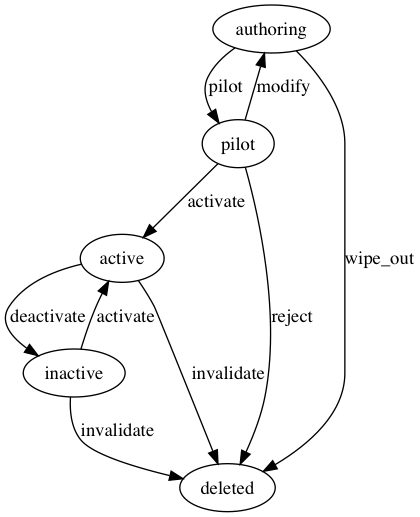Migrating from state_machine to aasm in Rails
First things first. State machines are awesome, be it any part of technology you use them in.
Recently at work, we passed many pipelines on migrating a very large Rails app from Rails 4 to Rails 5. One of the major parts of this change was shifting from state_machine to aasm for our state transitions. We rely heavily on state machines for how our instances shift states. Much of our tasks associated with the models too are integrated with the after/before actions of our state machines.

Need for transition:
One and only one reason, state_machine has been dead, and for quite some time. We shifted from Rails 3.2 to Rails 4.2 last year, and since it was a really, really painful migration, we fixed our focus on changed syntax and ActiveJob, found the much famous monkeypatch for Rails 4.2 and stayed happy for the time being with state_machine. Though there is state_machines_activerecord, we wanted to move to a more reliable and tested library, and as we already use acts_as_state_machine or aasm in one of our other projects, we tried and gave it a shot, when we began our Rails 5 voyage, for which of course neither state_machine and its patch worked, nor it was recommended.
What changed:
As it turned out, the process was not too messy. After a small study of the way both state_machine and aasm handle state transitions, one can easily find an analogy. Here are a few things which usually are a part of a state_machine laden project and how they should be modified to work with aasm
1. The gem itself
Goes without saying, remove from your Gemfile/gems.rb :
gem 'state_machine'and add :
gem 'aasm'2. Get rid of the state_machine monkey-patch if present
module StateMachine
module Integrations
module ActiveModel
public :around_validation
end
module ActiveRecord
public :around_save
def define_state_initializer
define_helper :instance, <<-end_eval, __FILE__, __LINE__ + 1
def initialize(*)
super do |*args|
self.class.state_machines.initialize_states self
yield(*args) if block_given?
end
end
end_eval
end
end
end
endYes, get rid of this if you have it, most probably in one of your config/initializers.
3. Transitioning the transitions:
This is the major part of the change and yet the easiest to implement. This includes code change in models. Take a look at the documentation over at aasm and start changing the code. Here are a few pointers.
add include AASM to your model
class Question < ActiveRecord::Base
include AASM
...
endspecify the column name on which you are observing state transitions, for eg. if the column name is state
class Question < ActiveRecord::Base
include AASM
...
aasm.attribute_name :state
...
endInitiate your state machine block by listing out all your states. The common way is using one line to specify your initial state, and a second line to list all your non-initial states
class Question < ActiveRecord::Base
include AASM
...
aasm.attribute_name :state
aasm do
state :authored, initial: true
state :piloted, :non_active, :active, :removed
...
end
...
endConvert your events. All event blocks of the form transition :a => :b will be replaced by transitions from: :a, to: :b
class Question < ActiveRecord::Base
include AASM
...
# State machine code
state_machine :state, initial: :authored do
event :pilot do
transition :authored => :piloted
end
event :activate do
transition [:piloted, :non_active] => :active
end
..
end
# AASM code
aasm.attribute_name :state
aasm do
state :authored, initial: true
state :piloted, :non_active, :active, :removed
event :pilot do
transitions from: :authored, to: :piloted
end
event :activate do
transitions from: [:piloted, :non_active], to: :active
end
...
end
...
endCallbacks like before_transition and after_transition from state_machine can be converted like this:
class Question < ActiveRecord::Base
include AASM
...
# State machine code
state_machine :state, initial: :authored do
before_transition :authored => :piloted, :do => :prepare_cockpit
after_transition :authored => :piloted, :do => :fly_the_plane
event :pilot do
transition :authored => :piloted
end
...
end
# AASM code
aasm.attribute_name :state
aasm do
state :authored, initial: true
state :piloted, :non_active, :active, :removed
event :pilot do
before do
prepare_cockpit
end
transitions from: :authored, to: :piloted, after: :fly_the_plane
end
...
end
...
def prepare_cockpit
...
end
def fly_the_plane
...
end
endHowever, in case of callbacks on a part of a transitions defined inside an event, one needs to define the transitions separately
class Question < ActiveRecord::Base
include AASM
...
# State machine code
state_machine :state, initial: :authored do
after_transition :authored => :piloted, :do => :fly
event :pilot do
transition [:inactive, :authored] => :piloted
end
...
end
# AASM code
aasm.attribute_name :state
aasm do
state :authored, initial: true
state :piloted, :non_active, :active, :removed
event :pilot do
transitions from: :authored, to: :piloted, after: :fly
transitions from: :inactive, to: :piloted
end
...
end
...
def fly
...
end
endif and unless guard blocks on transitions work the same way as in state_machine, and can also be substituted with a guard clause. The guards as well as callbacks can take arguments, lambda as well as Proc, same as the state machine guards
class Question < ActiveRecord::Base
include AASM
...
# State machine code
state_machine :state, initial: :authored do
event :pilot do
transition :authored => :piloted, if: :can_fly?
end
...
end
# AASM code
aasm.attribute_name :state
aasm do
state :authored, initial: true
state :piloted, :non_active, :active, :removed
event :pilot do
transitions from: :authored, to: :piloted, guard: :can_fly?
end
...
end
...
def can_fly?
...
end
endYes, that’s it for the models. You can take a detailed look at the docs if you have more complex needs.
4. The helpers:
One plus point for state_machine , it has/had a variety of useful helpers for making use of states and events in views and controllers. aasm, though lagging behind a little in this domain, still has a good pool of helpers, both class and instance to make good use of. Here are some pointers.
Question.aasm.stateswill give you an object list of all states available for theQuestionmodelQuestion.aasm.eventswill give you an object list of all events available for theQuestionmodelQuestion.first.aasm.stateswill give an object list of all states available for transitioning to for aQuestionobject, in this case the first one.Question.first.aasm.eventswill give an object list of all events that can be applied on the current state of theQuestionobject, i.e the first- All of the above helpers will produce an object list that contains name as the name of object, so appending
.map(&:name)will give a symbol array of the name of objects, that will come handy in drop-downs. Eg.
pry(main)> Question.last.aasm.events.map(&:name)
=> [:pilot, :deactivate]Another great point in favor of state_machine is its state_event attribute over the instance. For eg.
pry(main)> question = Question.first
pry(main)> question.state_event = :deactivate
pry(main)> question.saveThe code above will end up saving the question after calling the deactivate event over it. This attribute is highly useful in rails forms where one can easily pass what event to call from, and the transition will happen without extra hassle. Unfortunately, there’s no equivalent attribute cum method in aasm . But one can always write a common ActiveRecord::Base helper for the same.
On another note, the not-so-good-looking with_state / with_states scope methods of state_machine can be replaced by the enum equivalent syntax of aasm . For eg.
Question.with_state(:active) # state_machinegets replaced by a much cleaner :
Question.activeSo yes, a couple of tweaks here and there, and a good pool of existing test cases which run green, you are done and production ready. This will get you started, but do back yourself up with the aasm docs.
